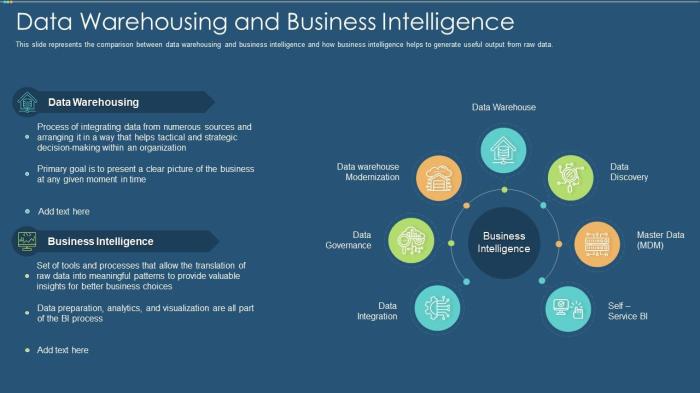In the realm of data-driven decision-making, data warehousing and business intelligence (BI) emerge as powerful tools, enabling organizations to harness the transformative power of their data. By integrating data from diverse sources, data warehousing lays the foundation for BI solutions that empower businesses to uncover hidden patterns, gain actionable insights, and make informed decisions that drive growth.
Data warehousing and BI form a symbiotic relationship, providing a comprehensive framework for data management and analysis.
Data warehouses serve as central repositories for vast amounts of structured and unstructured data, while BI tools transform this raw data into meaningful insights through visualization, reporting, and advanced analytics.
Data warehousing and business intelligence are essential for data-driven decision-making. Business intelligence tools help businesses analyze data to gain insights and make informed decisions.
Business intelligence vs business analytics are two closely related terms that are often used interchangeably. However, there are some key differences between the two.
Business intelligence focuses on providing historical data and insights, while business analytics focuses on predicting future outcomes. Both data warehousing and business intelligence are essential for businesses that want to make data-driven decisions.
1. Data Warehousing Fundamentals

A data warehouse is a central repository for storing and managing large volumes of data from various sources. It is designed to support data analysis and decision-making by providing a consolidated and consistent view of the data.
Implementing a data warehouse offers several benefits, including:
- Improved data accessibility and usability
- Enhanced data quality and consistency
- Increased efficiency of data analysis and reporting
- Better decision-making based on accurate and timely data
There are different data warehouse architectures, including:
- Single-tier architecture: Data is stored and processed on a single server.
- Two-tier architecture: Data is stored on one server and processed on another.
- Three-tier architecture: Data is stored on one server, processed on another, and presented to users on a third server.
2. Data Warehousing Technologies
Data warehouse technologies include:
- Relational database management systems (RDBMS): Store data in tables with rows and columns.
- Data warehouses: Specialized databases designed for storing and managing large volumes of data.
- Data marts: Subsets of data warehouses that focus on specific business areas or departments.
Each technology has its own advantages and disadvantages:
- RDBMS: High performance, scalability, and reliability; complex to manage and maintain.
- Data warehouses: Optimized for data analysis, complex queries, and large data volumes; expensive to implement and maintain.
- Data marts: Quick to implement, cost-effective, and easy to manage; limited data capacity and functionality.
Popular data warehouse vendors include:
- Teradata
- Oracle
- IBM
- Microsoft
- SAP
3. Data Integration and ETL

Data integration is the process of combining data from multiple sources into a single, consistent data store. ETL (Extract, Transform, Load) is a common data integration technique.
Data warehousing and business intelligence are crucial for organizations to make informed decisions. By leveraging data analytics and business intelligence , businesses can analyze large volumes of data, identify trends, and gain insights to improve operations and drive growth.
Data warehousing provides a centralized repository for data, while business intelligence tools enable users to explore and visualize data, ultimately enhancing decision-making and business outcomes.
Data integration tools include:
- Data integration platforms (DIPs): Comprehensive tools that provide a range of data integration capabilities.
- ETL tools: Specialized tools for extracting, transforming, and loading data.
- Data quality tools: Tools for cleaning, validating, and enriching data.
Best practices for data integration include:
- Use a consistent data model.
- Validate and clean data before loading it into the data warehouse.
- Monitor data integration processes to ensure data quality and accuracy.
4. Data Modeling and Design
Data modeling is the process of creating a logical representation of the data in a data warehouse. It involves identifying the entities, attributes, and relationships in the data.
Data modeling techniques include:
- Entity-relationship modeling (ERM): Represents data as entities and the relationships between them.
- Dimensional modeling: Represents data in a star or snowflake schema, with fact tables and dimension tables.
Best practices for data modeling include:
- Use a consistent naming convention.
- Document the data model thoroughly.
- Review and update the data model regularly.
5. Data Quality Management: Data Warehousing And Business Intelligence
Data quality management is the process of ensuring that data in the data warehouse is accurate, consistent, and complete.
Data quality dimensions include:
- Accuracy: Data is correct and free from errors.
- Completeness: Data is not missing or incomplete.
- Consistency: Data is consistent across different sources and systems.
Best practices for data quality management include:
- Establish data quality standards.
- Monitor data quality regularly.
- Implement data cleansing and validation processes.
Outcome Summary
As organizations navigate the complexities of the modern data landscape, data warehousing and BI have become indispensable allies.
By unlocking the potential of data, businesses can gain a competitive edge, optimize operations, and drive innovation. Embracing these technologies empowers organizations to make data-driven decisions, enabling them to thrive in an increasingly data-centric world.
FAQs
What are the key benefits of implementing a data warehouse?
Data warehouses provide numerous benefits, including improved data quality, enhanced data security, increased data accessibility, and reduced costs associated with data storage and management.
How can BI tools help businesses make better decisions?
BI tools empower businesses by providing interactive dashboards, reports, and visualizations that enable users to explore data, identify trends, and uncover insights that inform decision-making.
What are the challenges associated with data integration in data warehousing?
Data warehousing and business intelligence are closely related concepts, with business intelligence relying heavily on data warehousing for its data foundation.
A business intelligence description would typically involve gathering data from various sources, storing it in a data warehouse, and then analyzing it to extract valuable insights.
This process enables businesses to make informed decisions based on data-driven evidence, leading to improved performance and competitiveness.
Data integration can be challenging due to data heterogeneity, data quality issues, and the need to handle data from multiple sources in a consistent manner.
How does data governance ensure the integrity and security of data in a data warehouse?
Data governance establishes policies and procedures to ensure that data is accurate, consistent, and secure throughout its lifecycle, mitigating risks and maintaining data integrity.




